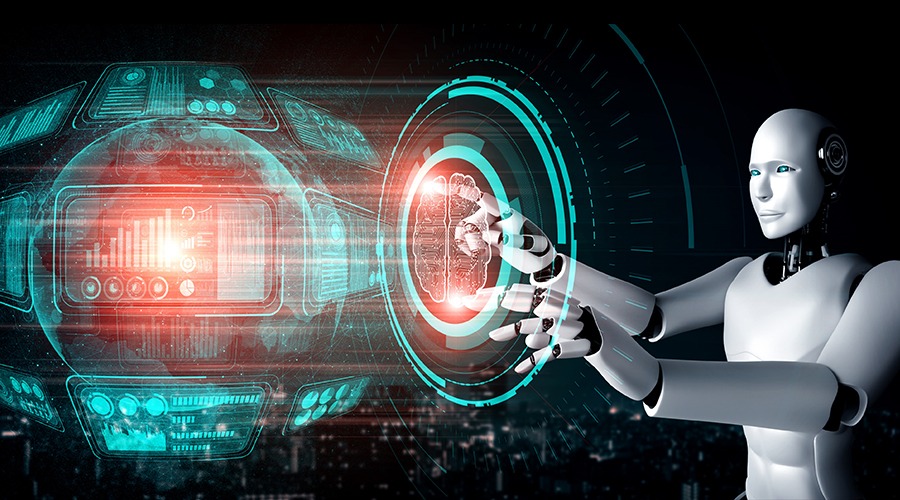What is Artificial Intelligence ?
Artificial Intelligence (AI) refers to the simulation of human intelligence in machines that are programmed to think and learn like humans. It encompasses a wide range of technologies and techniques that enable computers and software to perform tasks that typically require human intelligence. These tasks include problem-solving, reasoning, learning from experience, understanding natural language, recognizing patterns, and making decisions.
AI can be categorized into two main types:
- Narrow AI (or Weak AI): Narrow AI is designed to perform a specific task or a set of tasks. It operates within a limited context and does not possess general intelligence or consciousness. Examples of narrow AI include virtual personal assistants like Siri or Alexa, recommendation systems like those used by Netflix and Amazon, and autonomous vehicles.
- General AI (or Strong AI): General AI refers to a level of artificial intelligence that has the capability to understand, learn, and apply knowledge across a wide range of tasks, similar to human intelligence. General AI systems would have the ability to reason, solve problems, adapt to new situations, and understand context in a way that goes beyond specialized tasks. General AI remains a theoretical concept and has not been achieved as of my last knowledge update in September 2021.
AI technologies rely on various techniques, including:
- Machine Learning: A subset of AI that involves training algorithms on data to learn patterns and make predictions or decisions without being explicitly programmed. This includes techniques like supervised learning, unsupervised learning, and reinforcement learning.
- Deep Learning: A subfield of machine learning that uses artificial neural networks to model and solve complex problems. Deep learning has been particularly successful in tasks such as image and speech recognition.
- Natural Language Processing (NLP): The branch of AI that focuses on enabling machines to understand, interpret, and generate human language. NLP is used in applications like chatbots, language translation, and sentiment analysis.
- Computer Vision: AI systems designed to interpret and understand visual information from the world, often used in tasks like object recognition and image analysis.
AI has a wide range of practical applications across industries, including healthcare, finance, transportation, entertainment, and more. It has the potential to automate repetitive tasks, improve decision-making processes, enhance efficiency, and advance our understanding of complex systems. However, it also raises ethical and societal concerns, such as job displacement, bias in algorithms, and privacy issues, which need to be carefully addressed as AI continues to advance.
AI Can Outperform Humans In Most Occupations
As of my last knowledge update in September 2021, AI had demonstrated the capability to outperform humans in certain specific tasks and occupations, especially those that involve data analysis, pattern recognition, and repetitive tasks. However, it’s important to note that AI’s ability to outperform humans in most occupations is not universally true, and there are several factors to consider:
- Task-specific vs. General Intelligence: AI excels in tasks that can be narrowly defined and where large datasets are available for training. In contrast, human intelligence is more versatile and adaptable, allowing humans to perform a wide range of tasks that require creativity, empathy, complex decision-making, and social skills. Many jobs, especially those involving creativity, complex problem-solving, or human interaction, still rely heavily on human capabilities.
- Complementary Roles: In many cases, AI is seen as a tool that complements human workers rather than replacing them entirely. AI can automate routine and repetitive tasks, allowing humans to focus on higher-level decision-making, creative work, and tasks that require emotional intelligence.
- Ethical and Social Considerations: The deployment of AI in various occupations raises ethical and societal concerns. Decisions about where and how AI is used must consider issues related to job displacement, bias in algorithms, transparency, accountability, and the impact on society.
- Implementation Challenges: Implementing AI in complex real-world environments often presents challenges. AI systems require extensive training data, maintenance, and continuous improvement. Integration with existing systems and processes can be complex and costly.
- Cultural and Regulatory Factors: Cultural acceptance and regulatory frameworks also play a significant role in determining the extent to which AI can replace human workers. Some societies may resist the widespread adoption of AI in certain roles due to cultural or ethical reasons.
It’s worth noting that the landscape of AI and automation is continuously evolving. AI technologies are advancing, and their capabilities are expanding. However, the degree to which AI can replace humans in different occupations will vary depending on the specific job, industry, and context.
To address the potential challenges associated with AI adoption, policymakers, businesses, and society as a whole need to consider how to responsibly and ethically integrate AI into the workforce, ensuring that it benefits both the economy and the well-being of individuals. This might involve reskilling and upskilling the workforce, creating new roles that leverage AI, and developing regulations that ensure fairness and transparency in AI systems.




